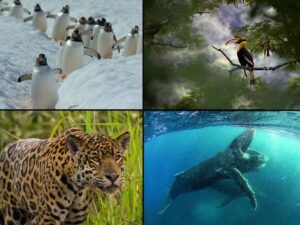Watching TV vs. Everything Else –And a Recommended Docuseries

I didn’t watch a ton of TV as a child. I’m sure I would have if I could have, but my parents preferred their children to spend their spare hours reading books.
When I left home, I was, in theory at least, free to binge-watch TV day and night. But I didn’t. By then, I had absorbed my parents’ disdain for the “boob tube.” And when K and I had children, we passed it on to them.
The thing is, it was a lot easier to stay away from TV when I was a kid – and even when our children were young – than it is today. And that’s because there are so many more things to watch. Hundreds more. And a fair percentage of them are GOOD.
Here’s an example…
I’m not a nature guy. I much prefer to vacation in a city than in the mountains. And I carried this prejudice into my TV viewing habits. I don’t think I ever watched a show about nature till just last week. What changed that was giving a Netflix documentary series called Our Planet a try. Within minutes of watching episode one of the first season, I was enthralled.
What makes the series so appealing to me is how amazingly well it’s produced. From the script to the informational content to the photography and the narration, it’s a constantly rewarding way to spend some of my down time.
I watched the first two episodes of Our Planet II tonight. Two in a row. That’s not something I normally do. The last time I did it was at least 10 years ago. I binge-watched 24. (Remember that series with Kiefer Sutherland?)
The episode I just finished is titled “Following the Sun.” The motif is the relationship between the rotation of the sun, which causes significant temperature changes all over the world, and the migration of animals. It’s a topic I’ve never given much thought to. And a topic I probably don’t really need to know much about.
But I watched it. And I learned some marvelous things.
Did you know that many animals – thousands of species – migrate as the seasons change? That would include most four-legged mammals, all sorts of birds, many fish, and many creatures smaller than fish. They migrate because of necessity. If they don’t get to a warmer climate in time, they die. That’s easy enough to understand. What’s surprising, though, is how they migrate.
The episode followed dozens of creatures on their long and super-challenging trips, often traveling thousands of miles populated with predators eager and able to consume them.
Some animals, like lions, don’t move. They just stay where they are and wait for the animals they feast on to migrate their way.
Some sharks travel and some don’t. When it’s time for albatross to migrate, the local sharks hang out along the coastline where the chicks mature into adults and then attack them as they try to lift themselves above the water. This life-and-death fight is amazing to watch. You can’t help but root for the albatross.
Did you know that bees migrate? They do. They migrate when there are just too many of them. A single hive can accommodate 100,000 bees. When it gets overcrowded, a small number of bees act as “scouts” to search out better living quarters, with just the right amount of sun and shade, and of a size that could accommodate a new tribe. The details of how they spread the news of what they’ve found are mesmerizing.
The migration habits of Snow Geese are equally remarkable. Snow Geese lay eggs only once a year, in the arctic summer. The females lay the eggs and keep them warm, while the males protect them from the foxes… and then the bears. Just eight weeks after hatching, the little goslings must make their first flight all the way to the warmth of the Gulf of Mexico.
The stories are fantastic. So, too, is the photography. I have no idea how they managed to get close-ups of, for example, the inside a new bees’ nest as it formed… or lions hiding in the grass as wildebeests passed by, hoping to feed themselves or die.
You can watch the trailer for Our Planet here.
And the trailer for Our Planet II here.





